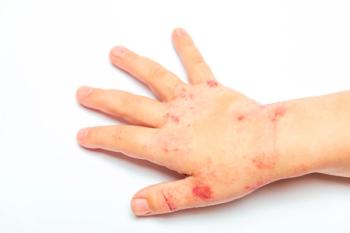
Twenty-Nail Dystrophy (or “Sandpapered Nails”)
Gradual alterations in all 20 nails prompted this teenager to seek care. He had no associated symptoms. He had not experienced hair loss, nor any other cutaneous or scalp lesions.
This teenager sought medical attention after noting gradual alterations in all 20 nails. He had no associated symptoms. He had not experienced hair loss, nor development of any other cutaneous or scalp lesions.
Key point: All finger and toenails displayed similar morphologic changes: the nails were dull, thin, fragile, and appeared rough-surfaced. As noted on the middle nail, a few nail pits were also found. This is the appearance of an entity called twenty-nail dystrophy (or “sandpapered nails”).
This disorder is felt most often to be a reflection of lichen planus of the nail matrix, but it can also be seen in conjunction with psoriasis and alopecia areata. Neither of the latter two disorders were manifest in this particular patient.
Treatment: While the condition may resolve spontaneously, topical corticosteroids can be applied to the posterior nail fold, presumably to reduce inflammation in the underlying nail matrix. This patient declined therapy once reassured that the condition was harmless.
Note: Individuals with vitiligo are at increased risk for this nail disorder.
Newsletter
Access practical, evidence-based guidance to support better care for our youngest patients. Join our email list for the latest clinical updates.








